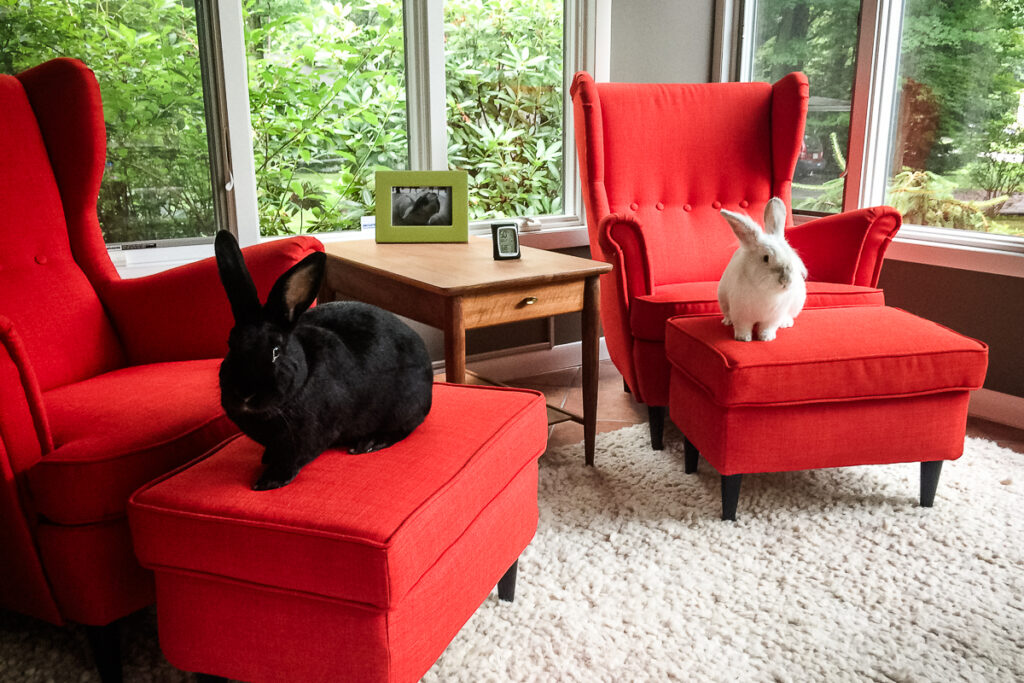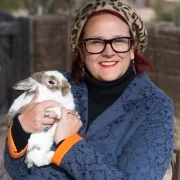The Word for Rabbit in Different Languages
Or…A rabbit by any other name is still a rabbit.
A note on organization
Languages are listed alphabetically according to language family. A language family is a group of languages which derive from a common mother language. For instance, many of the languages of Europe, West Asia, and the Subcontinent (such as German, Russian, Latin, Sanskrit,Persian, Armenian, Greek, etc.) belong to the Indo-European family of languages. Due to the many similarities in pronunciation, grammar, and vocabulary between these languages, linguists believe that there was at one time a single language, called Proto-Indo-European, from which these ultimately derived.
Languages can be further subdivided into branches. For instance, English, German, Dutch, Swedish, Danish, and Norwegian are much more similar to each other than Russian, Polish, Czech, Serbian, and Ukranian. The first set of languages belongs to what is called the Germanic branch, while the second set belongs to the Slavic branch. Yet they are all Indo-European languages. (Compare the words for rabbit in the Germanic and Slavic languages given below.)
Some language families, such as Indo-European, have been exhaustively studied over the past century and are well-established by linguists, while others, such as Amerind and Altaic, are far more controversial. This web site is not attempting to make definitive statements on the classification of languages! More controversial language families have been adopted here merely as a convenience. Remember, it’s all for fun!
A note on submissions
If you speak a particular variety of a language (e.g., Swiss German and Bavarian are varieties of German), please be sure to include this information in your e-mail. This is a great help when sorting out multiple submissions for one language. Please send your words for rabbit For languages written in a non-Roman script, feel free to include a gif or jpg of the word written in the native script.
| Afro-Asiatic (languages spoken in Northern Africa and the Middle East) | |||
| Cushitic | |||
| Somali | bakayle | ||
| Arabic | arneb | ||
| araanib | |||
| arnab | |||
| arnab bari | (wild rabbit) | ||
| arnob | (bunny – baby rabbit) | ||
| Hebrew | arnevet (hare) | ||
| arnavon/arnavoni | (little sweet bunny) | ||
| shafan | |||
| Maltese | fenek | (rabbit) | |
| fenek abjad | (white rabbit) | ||
| fenek iswed | (black rabbit) | ||
| zermug | (baby rabbit | ||
| Altaic (languages spoken in Turkey, Central Asia, Siberia and East Asia) | |||
| East Asian | |||
| Japanese | usagi | ||
| Korean | toki | ||
| San Toki (‘Mountain Rabbit’) is a popular children’s song: ‘Mountain Rabbit, Rabbit/ where are you going?/As you hop hop hop,/ where are you going? | |||
| Turkic | |||
| Kazakh | kenek | ||
| Turkish | oda tava_ani | ||
| Amerind (includes most of the indigenous languages of North and South America) | |||
| Algonquian | |||
| Ojibwe | waabooz | ||
| Iroquoian | |||
| Cherokee | tsi s du Penutian | ||
| Chinook | quetshadee | ||
| Siouan | |||
| Dakota | mastinca | ||
| Aztecan | |||
| Nahuatl | ometochtli | ||
| Austroasiatic | |||
| Vietnamese | tho | ||
| Austronesian (languages spoken in Taiwan, Oceania, Madagascar and Hawai’i) | |||
| Malayo-Polynesian | |||
| Bahasa Malaysia | arnab | ||
| Hawaiian | lapaki | ||
| Indonesian | kelinci | ||
| Maori | raapeti | ||
| Malagasy | bitro | ||
| Malay | kelintji arnab | ||
| Tagalog | kuneho | ||
| Dravidian (languages spoken mostly in southern India and Sri Lanka) | |||
| Tamil | muyal | ||
| Eskimo-Aleut (languages spoken in northern Alaska, Canada and Greenland) | |||
| Eskimo | ukalerk | ||
| Eskimo (Inupiaq) | ukulaitchiaq olark | ||
| Kadai (languages spoken in Southeast Asia) | |||
| Thai | gra-dty | ||
| Indo-European (languages historically spoken in Europe, West Asia and the Subcontinent) | |||
| Albanian | |||
| Albanian | lepur (hare) | ||
| lepurush (bunny) | |||
| Armenian | |||
| Armenian (Western) | nabastak | ||
| Armenian (Classical) | napastak | ||
| Baltic | |||
| Latvian | trusis zakis (hare) | ||
| Lithuanian | kralikas zuikutis | (small bunny rabbit) | |
| Celtic | |||
| Irish | coinân giorria (hare) | ||
| Cornish | conyn conynas | (plural) | |
| Manx | coneeyn conning | (bunny) | |
| Gaelic | coineanach coineagan coineanach an taighe | ||
| (house rabbit) | |||
| Welsh | cwningen | ||
| Germanic | |||
| Afrikaans | haas (hare) | ||
| konyn | |||
| Bavarian | kinihÔs | ||
| Danish | kanin | ||
| Dutch | haas (hare) | ||
| konijn (bunny) | |||
| konijntje (bunny) | |||
| nijntje | (used as an affectionate term.) | ||
| Also a famous cartoon rabbit in Holland. | |||
| English (Archaic) | coney | ||
| Flanders | keun | ||
| Flemish | konijn keun | ||
| Frisian (Wester Lauwer) | knyn hazze (hare) | ||
| German | Kaninchen (rabbit) | ||
| Hase (hare) | |||
| Icelandic | kanina | ||
| Norwegian (BokmÔl) | kanin | ||
| Swedish | kanin | ||
| Swiss German | Hassli (small hare) | ||
| Chungel | |||
| Swiss German (Basel region) | ChÉngel | ||
| Yiddish | krolik | ||
| Hellenic | |||
| Greek (Modern) | kouneli | ||
| Greek (Classical) | lagos | ||
| Indic | |||
| Bengali | chorgosh | ||
| Gujarati | saslu | ||
| Hindi | khargosh | ||
| Classical Sanskrit | shashaka | ||
| Vedic Sanskrit | shasha | ||
| Sinhalese | haava haapetiya | (baby rabbit) | |
| Urdu | kargosh | ||
| Iranian | |||
| Kurdish | karwesh | (literally, ‘donkey ears’) | |
| Persian (Farsi) | khargoosh | ||
| (literally, ‘donkey ears’) | |||
| Italic | |||
| Aragonese | coniello | ||
| Catalan | conill | ||
| French | lapin lapereau | (young rabbit) | |
| lapin de clapier | (tame rabbit) | ||
| Italian | coniglio | ||
| coniglietto | (bunny) | ||
| Latin | cuniculus | ||
| Was also used for soldiers who dug tunnels | |||
| cuniculosus | (full of rabbits) | ||
| lepus | (hare) | ||
| Portuguese* | coelho | ||
| coelha | (female rabbit) | ||
| coelhinho | (little rabbit) | ||
| lebre | (female hare) | ||
| lebrÉo | (male hare) | ||
| *Note: several of our documents are available in Portuguese. | |||
| Romanian | iepure iepura | (bunny) | |
| iepurime | (warren of rabbits) | ||
| iepuroaica | (female rabbit) | ||
| iepuroi | (male rabbit) | ||
| Spanish | conejo conejito | (little rabbit) | |
| Slavic | |||
| Bulgarian | zayek | (rabbit, hare) | |
| Czech | králík (kra:li:k) | rabbit | |
| králíček (kra:li:czech) | little rabbit | ||
| Croatian | kunic zets | ||
| Macedonian | zajak zajache zajko | ||
| Montenegrian | zec | ||
| Polish | królik | ||
| króliczek | (bunny) | ||
| Russian | krolik zayets zaychek | (endearing form for bunny) | |
| Serbian | kunit | ||
| Slovak | králik | ||
| Slovene | kunec zajec | (hare) | |
| *Note: the word zajec or diminuitive zajcek is more generally used for both species. It can also be a person’s first name. | |||
| Ukranian | kril’ kri-lyk | (domesticated) | |
| kri-lyky | (domesticated, plural) | ||
| zaichyk | (endearment) | ||
| za-yats’ | |||
| Niger-Kordofanian (languages spoken in West and Central Africa) | |||
| Bantu | |||
| Lozi | shakame | ||
| Swahili | sungura | ||
| Swati | umgwaja | ||
| Xhosa | umvundia | ||
| Zulu | unogwaja | ||
| Nilo-Saharan (languages spoken in the Sahara and Central Africa) | |||
| Lwo | apwoyo | ||
| Sino-Tibetan (languages spoken in Mainland China, Taiwan and Southeast Asia) | |||
| Burmic | |||
| Burmese | youn | ||
| Sinitic | |||
| Cantonese | pak toi | (white rabbit) | |
| yah toi | (wild rabbit) | ||
| toi bao bao | (baby rabbit) | ||
| Chinese (Mandarin) | tu zi (rabbit) | ||
| baitu (white rabbit) | |||
| xiao baitu (little white rabbit) | |||
| Taiwanese | to-ah | ||
| Tibeto-Karen | |||
| Tibetan | reepong | ||
| Uralic (languages spoken in northern Scandanavia, Finland, Estonia, Hungary and Siberia) | |||
| Finno-Ugric | |||
| Estonian | kodu-janes | (tame hare) | |
| Finnish | jÉnis kani | ||
| Hungarian | házinyúl | ||
| Language Isolates (languages that have no clear connections with any other language. They are found throughout the world.) | |||
| Basque | untxi | erbi (hare) | |
| Artificial Languages | |||
| Esperanto | kuniklo | ||
This list was begun in 1993 by Paige Parsons. Margo DeMello also helped to expand and maintain it over the years.


